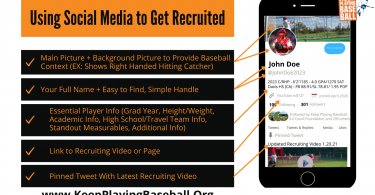If you recently reached out to a college program of interest and waited for a reply that never came, you are not alone. This is a pretty common experience for recruits. College coaches get dozens and dozens of interest emails each day and their lack of response could mean any number of things from never getting a chance to read your email or not having time to respond to reading your email and having no interest in considering you as a recruit. One thing is certain, if the timing is right for the program, they receive your email and are interested, they’ll make the time to let you know. But if you don’t hear back, don’t know why you didn’t hear back and are still interested in the program, what should you do now? In the remainder of this article, we outline additional steps you can take to follow-up on your first failed email attempt which will give you the best chance of getting a response from a college coach.
STEP 1: Evaluate the timing of your email
- Do the recruiting rules allow the coach to contact you back? Check here.
- Is the program likely to be recruiting players in your graduating class?
- Does your skill set match the type of players that the program is likely to recruit? Check here for more.
- Busy times of the college season (start of the season, playoffs, during a road trip, etc.) make it less likely that you will get a timely response or a response at all. Are you contacting the coach at a time of the year when they will be more likely to get back to you (summer/fall)?
If the answer to these questions is yes, move on to Step 2. If the answer is no, wait until the timing is better then move on to Step 2.
Step 2: Evaluate the quality of the email
- Did you follow KPB’s introductory email guidelines? Check here.
- Did you send the email to the right coaches? Head coaches rarely respond to emails, they simply don’t have time. Make sure you direct the email to the head coach and assistant coaches and CC all the assistants.
- Did you personalize the email (address the coaches by name and write a sentence or two specifying why the program is of interest to you)?
- Is the email short and concise (a short paragraph or two)?
- Do you provide them with the information needed to evaluate you as a potential fit (provide a video link, grades, contact info, etc.)?
If the answer to these questions is yes, move on to Step 3. If the answer is no, fix the issues with your email then move on to Step 3.
Step 3: Send a follow-up email
Once you’ve made sure that the timing and the content of the email are right, and have checked for spelling and understanding, send a follow-up email. Let the coaches know that you are following up on your previous email and remain interested in their program. Include the revised content of the introductory email in in the follow-up.
Step 4: Wait for a response and evaluate next steps
Once you’ve sent your follow-up email, wait a week or two for a response. If you still haven’t heard back from the program, move on to step 5. If you hear back, check KPB’s resources on communicating well with college coaches here.
Step 5: Have your coach or a well-respected baseball source reach out to the school on your behalf
If you’ve initiated interest and still haven’t heard back, having someone who knows college baseball well and will vouch for your ability reach out to follow-up can help. College coaches value the honest opinion of youth coaches and this can often get the coaches to give you a more thorough review, at the very least.
If your coach or a respected baseball source reach out on your behalf and you still hear nothing from the program, you have several options:
Option 1. Continue to pursue the school immediately
This option is best for upperclassmen who are extremely interested and have limited time. In addition to sending email updates to the coaching staff periodically (every 6-8 weeks) so they can stay on top of your development and you stay fresh in their mind, you can also pursue more aggressive forms of being evaluated by the coaching staff, including attending camps and showcases at their school or where you know you will be present and have a chance to see you play.
Option 2. Take a prolonged break before trying to initiate interest again
This is a great option for underclassmen who have plenty of time to improve and try to re-engage the coaches. If your first few attempts to express interest in a program fall short, it’s fair to assume that they need to see more from you. Take time to let your skills improve and focus on your development. Improve on your strengths and work hard on your weaknesses. Use the weight room to improve your physicality and strength. If you make a jump in skill level over a period of time, it can absolutely change a program’s mind. Take the time to get better before reaching out again.
Option 3. Assume the program is not interested and move on to other options
Depending on your level of interest in the program, you may decide it best to count your losses and move on. There are over 1600 college baseball programs out there and it can sometimes be best not to get hung up on one single program.







